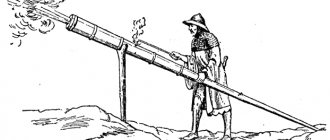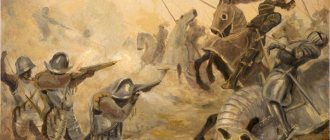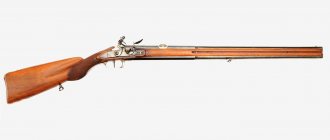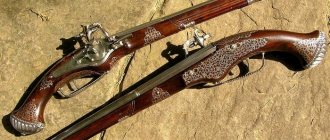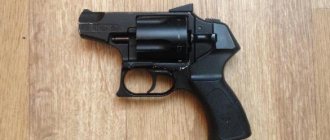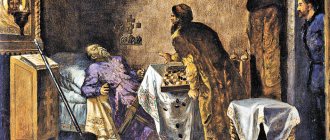Slavic weapons
Lubor Niederle. Slavic antiquities. Book two. Life of the ancient Slavs.
Chapter XI. Warfare. Slavic weapons.
At first glance, it seems that in terms of weapons, the ancient Slavs were extremely poor until the very end of the pagan period. In Slavic burials of the 9th and 11th centuries, weapons are found very rarely (38), and in a number of ancient reports the Slavs are spoken of as if they had no weapons . Jordan characterizes the Slavs of the 4th century as “armis despecti” - “despicable armies” (39), Constantine Porphyrogenitus even speaks of them as “εθνη σκλαβινικά άοπλα δντα” - “Slavic simple peoples” (40), the same is the meaning of several more messages below.
However, contrary to this, we know that the entire history of the settlement of the Slavs often testifies to big battles, and also the history of the first centuries after the settlement of the Slavs in new historical places of residence is full of large and often victorious battles with the Turkic-Tatars, Greeks and Germans . There are a number of other historical reports that talk about the diverse military equipment of the Slavs , and the already known statement of John of Ephesus from 584 that the Slavs learned to wage war better than the Romans , with all its exaggeration, still contradicts the words of the Emperor of Byzantium Constantine: “εθνη άοπλα” - “unarmed peoples”. The contradiction between the above reports and archaeological data, on the one hand, and the entire historical development, on the other, is only apparent and is easily explained.
In ancient times, the Slavs were indeed few and poorly armed, since they did not fight with anyone. When they left their ancestral home, they had almost no weapons, at least metal ones; all of it was limited to small bows with arrows, pointed wooden spears and shields made of twigs or leather. This is how the ancient authors portrayed the Slavs, so for the Goths of the 3rd and 4th centuries the Slavs were “armis despecti” - “unarmed” ; historians of the 6th–8th centuries characterize their weapons in the same way, some of whom met the Slavs in person: Procopius, Mauritius, Leo VI, John of Ephesus, Michael the Syrian, Paul the Deacon, as well as the ancient source used by Ibn Ruste and Gardizi (41), and, finally, only this could have been meant by Emperor Constantine when, based on these ancient sources, comparing the weapons of the Slavic warriors with the weapons of his Roman heavily armed warriors, he called them “εθνη άοπλα” - “unarmed peoples.”
The armament of the Slavs was insufficient in the 3rd - 4th centuries AD. e., but in subsequent centuries the Slavs were able to develop it and improve Russian armor of the 10th-17th centuries according to German, Roman-Byzantine and Eastern models . It is impossible to imagine that the Slavs still had the same imperfect weapons if John of Ephesus, when describing the Slavic attacks on Greece , says that they learned to use military equipment and wage war better than the Romans and their legions (Latin legio, gender legionis, from legio - collecting, typing).
So, it is obvious that if at first the Slavs were indeed poorly armed and their weapons were imperfect, then by the end of the pagan period - by the 10th-19th centuries - everything had changed. By that time, the Slavs had already borrowed a lot from the Germans, Romans and peoples of the East .
The spear, bow and Russian shield remained characteristic Slavic weapons (42), but along with them appeared the Russian sword, dagger, saber and defensive weapons - the armor and helmet of the 10th century.
The turn in the rearmament of the Slavs occurred in the 10th and 11th centuries, on the Balkan Peninsula even earlier, and reports from that period paint a different picture than the ancient reports above (43).
In Slavic burials of the 10th and 11th centuries, weapons are rarely In those days, everywhere, and mainly where Christianity was introduced by the Roman Church , burial goods, and therefore weapons, were no longer placed in graves. Charlemagne in 785 banned pagan burials in the Frankish Empire , subsequently the entire Slavic west followed his example, and in the east they soon abandoned the ancient custom of grave offerings. Burials of Christian warriors in full armor are found only as an exception, for example, burials from Taganchi near Kanev or near Kolin in the Czech Republic (44). Although we sometimes find entire large German cemeteries of the Merovingian era devoid of weapons, no one doubts that the German warriors of the 5th–7th centuries were well armed.
Armament of a Russian warrior from a 10th-century burial discovered in Taganch near Kanev (according to Khoinovsky) Let us move on to the description of individual types of weapons (45).
Sword, saber.
The Germans and Romans became familiar with the long from the Gauls (Celts) and adopted it from them. In the Merovingian era, the "spata" of the Germans developed into a characteristic heavy form with a short crosshair and a cone-shaped pommel, and the Slavs in turn borrowed this form from the Germans in the Carolingian era. However, the borrowing of a Germanic name, derived from Gothic. meki, and its transition to Common Slavic: sword dates back to a later era; this term also passed to the Finns: miękka, and to the Lithuanians: meczus. (46).
Swords from Slavic finds: 1 – Hohenberg; 2 – Kolyany near Vrlika; 3 – Jarniewice; 4 – Kyiv; 5 – Gnezdovo; 6 – Oder, near Goltsov.
The sword from Slavic burials of the 8th–11th centuries is similar to a German sword from the time of Charlemagne and is most often an import from Frankish workshops that supplied swords to the Scandinavian Vikings. The Frankish sword is decorated with a characteristic Germanic serpentine ornament; we also encounter Slavic imitations of Frankish swords (47).
From Sanskrit: Kavaka - kavaca - armor, shell, chain mail. “Kavasa” - kavasa - chain mail, armor. Both words were preserved in the Russian language in words with the root “ kov” - forge, forged, okovy, koval - in the Ukrainian language, as well as in the word “cavalry” - warriors, riders on shod horses.
Kanchuka – kañcuka – chain mail, armor made of many rings (with the root “stake”, “colo” - “circle”); armor that fits tightly to the upper body, armor. The root “kanq” - kañc - 1) to bind, 2) to “shine” (prince)
Other types of swords of Byzantine or Eastern forms , among which the smooth sword with one blade, the broadsword, or kord , are especially interesting, are rarely found in the Slavic lands of that time (48). Single-edged swords most common in Hungary, where, as Gampel explains, they developed from curved sabers under the influence of Frankish swords. The word broadsword comes from Turkish. pala , the word kord, in Church Slavonic. korda - from Iranian language
The Jurko-Tatar curved and one-sided saber , Old Slavonic: saber, is also found already in this era among the Slavs, but comparatively very rarely. The Kiev Chronicle, at the end of the 10th century, distinguishes Russian weapons, which were characterized by armor and a sword , from the Turko-Tatar with a bow and saber (50), and until the 11th century , the chronicle nowhere mentions sabers in the hands of Russian soldiers. Starting from the 11th century, the saber penetrates, however, to the Slavic Rus (see the grave at Taganchi) and further. The saber came to the Slavs in Hungary even earlier. Here one can also clearly distinguish the ancient form of the Avar saber , equipped with a tooth on the crosshair, from the later Magyar one with a broken crosshair and without a tooth (51).
Reconstruction of the weapons of a warrior from Taganchi.
It should also be emphasized that with a lack of swords, which were still rare, the Slavs also fought with large knives, which is attested for the Western Slavs by the life of Bishop Altman at the end of the 11th century or the Christian legend, and for the Eastern Slavs - by the “Tale of Igor’s Campaign” of the end of the 12th century ( 52). Knives were worn in boots, and they were called shoemakers . However, large knives are very rare in finds.
Ax.
Although the ax (Old Slavonic ax or adze) is a very ancient type of tool and weapon, it was attested to by the Slavs relatively late. The first reports that the Slavs fought with axes date back to the 8th century (53). Despite this, I have no doubt that the ax was an ancient Slavic weapon. Subsequently, it became a very common type of weapon and, starting from the 8th century, is often found in archaeological finds. There are ancient forms of axes, known to us already from Roman finds, with blades of various shapes, sometimes narrow, sometimes wide. The Merovingian Francis is no longer found.
From the east, a light ax with an elongated butt part and a hole for the handle located in the middle part of the weapon penetrated to the Slavs. The ax is sometimes found in Russian finds and often in Hungary. The best example is a light ax inlaid with gold and silver from Bilyarsk near Chistopol, dating back to approximately the beginning of the 12th century (54).
In this eastern form, axes came to the Slavs, and the new eastern terms chakan (from Turkish) and ax came from Iranian or Persian languages. barta , was borrowed from the Germans even earlier . boards, Old Bulgarian: brady ( 55).
Iron ax of Russian work , inlaid with gold and silver, from Bilyarsk (according to V. Sizov)
Along with axes with a sharp blade, in Slavic lands there are sometimes clubs with a blunt hammer without a blade or with a knob equipped with grooves or spikes.
Single-edged broadsword and saber from Slavic and nomadic finds: 1 – Yurkovo (Koshchany); 2 – Keshkemet; 3 – Zemyanskaya Olcha; 4 – Czechowice; 5 – Tagancha; 6 – Tops. Saltovo; 7 – Kuban (Caucasus).
Their shape and purpose were different, and therefore there are a number of names for them, both Slavic: club, mlat, rod, mace, feather, butt , and foreign, eastern: buzdyganb, śestopiorb (six-footer) from Persian. śeśper.
Iron
pernach from Sakhnovka and bronze flails from Kiev and Kanev
However, it is difficult to establish which form belonged to which name. It is also impossible to establish exactly what time they belonged to. It goes without saying that the common people, along with these often luxurious clubs , also used simple strong clubs (syllable kyjb, hence Kiev ), which, however, we also saw among the warriors depicted on the carpet from Bayeux .
Slavic battle axes 1-3 – V. Goritsa; 4, 6 – Luhačovice; 5 – Zdanice; 7 – Turovo; 8, 12 – Dnieper valley; 9 – Saki (Porechye); 10 – Syazniga on the river. Pasha, Ladoga region; 11 – Liplavo (Zolotonosh); 13 – Spassky Gorodets (Kaluga province); 14 – Gnezdovo; 15 – Prince Mountain (Kanev); 16 – from the vicinity of Vilna; 17 – Borki on Oka; 18 – Ax – the hammer of the nomads, Vakhrushev, Tikhvin district.
Spear, bow.
The next two types of weapons - a spear and a bow with arrows - are, as we already know, ancient and typical Slavic weapons. Along with simple wooden stakes, pointed at the ends (Russian oskp ), the Slavs had two types of weapons equipped with iron tips : one a tip at one end (Old Slavonic: spear ), the other had a tip at both ends (Staroslav. sudlitsa ) . The shape of the tip is as varied as that of weapons of that time in Western Europe and Germany. The tip has a sleeve for attaching to the shaft.
From Sanskrit: Kupia – kupya – Spear.
Lokaka - locaka - bow (titiva) (related words in Russian: bow, ray, archer...)
AkArshana – AkarSaNa – bend (bow) ; to ARSHATI - karSati - to attract, attract, bend (bow).
“arshin” has been preserved in Russian it means a measure of length: 71 cm . - this is the standard distance for the tension of the bow string, the distance of an outstretched arm, in Latin “arcus” - “bow” , hence the word “ arch” - a ceiling arch arched.
Sometimes there are also spears with wings, and on the shaft of the spear there are lateral processes, similar to the examples known in the West, and also often found in miniatures of that time. The bow (Old Church Slavonic: lękb played a big role among the Slavs , Old Church Slavonic: arrow, thorn (56) - in the east for a long time. In the west, from the time when the Western Slavs met the Avar and Magyar archers and were forced to adapt their tactics to them, strengthening the role of the bow. The word arrow is of Germanic origin, Old High German: strala, and ancient. The word thorn originally meant a thorn on a wild rose, later an arrowhead.
A whole bow was not found in Slavic burials (57), but a whole bow was found by N. Repnikov at the site of Staraya Ladoga, but this bow is unlikely to be Slavic, it was similar to a South German bow from a burial at Oberflacht or a Scandinavian bow from a swamp near Nydam; There is also no doubt that the bows were made from a smooth and relatively long ash branch (58). However, the Central Asian bow, composed of two curved parts like a wide M, known to us from Scythian and Sarmatian burials, as well as from Parthian and Persian images of the Sasanian era, also penetrated to the Eastern Slavs (59). But this form was not the original Slavic form.
Electric vessel from the Scythian royal mound Kul-Oba (Kerch, Crimea)
The shape of arrowheads is very diverse: along with the forms common throughout Europe, we also encountered eastern forms - with a blunt or serrated end. When archery, the Slavs, like their closest neighbors, used arrows soaked in poison , which they called pater . Most likely, this poison was made from aconite (Aconitum napellus) and, according to Mauritius and Leo, its effect was so rapid that if the wounded did not immediately apply an antidote (theriaka) or did not excise the affected area, death would occur (60)
Spearheads from Slavic burials: 1, 9 – Nikolaevka; 2 – Branovice; 3, 8 – Gnezdovo ; 4 – Gulbishche; 5– Spassky Gorodets; 6 – Rostkovo; 7 – Lubovka; 10 – Tunau; And - Bezdekov.
Forms of Slavic arrows I-7 – from burials of Ostersky district; 8-10 – from Prince Mountains; II-13 – from Gulbishche and Black Grave; 14–15 – from V. Goritsa; 16–22 – from Gnezdovo.
Eastern arrows: 1 – Minusinsk; 2 – Moshchinskoye settlement (Kaluga province); 3 – Vishenki (Chernigov province); 4 – Pilin; 5 – Belorechenskaya; 6 – Transcaucasia.
The arrows were carried in a special case (Old Church Slavonic: tul ), which was suspended on a belt at the left side . The Eastern Slavs adopted from the Asian nomads another special case for a bow, which they wore on the right side and was called a bow (61).
Sling.
Throwing stones using hand slings is an ancient method of combat, which the Slavs undoubtedly used for a long time. The first documents about this date back to the battle of Thessaloniki in the 7th century (62).
sling
To designate a case for arrows, the ancient Russians also adopted the Turkic term quiver , and subsequently for the entire set the Mongolian name sadak or sagadak . The method of throwing did not differ then from the method presented in one of the scenes of the Bayeux carpet (63).
The common Slavic name for the device necessary for throwing was prak (vice) from the original pork (64). However, initially, in the 12th century, this word appears as a designation of a device with which large stones were thrown during the assault on fortified cities.
Shell.
The imperfection of the weapons with which the Slavs fought back in the 6th and 7th centuries was also associated with the fact that in this era they did not have either metal armor or metal helmets, in addition to the exceptions mentioned above. However, at the end of the pagan period, in the 10th and 11th centuries, shells were already widely known and were called brnya, armor. It is a word of Germanic origin, derived from Old High German brunja , German. Bgunne (65), which indicates that the Slavs borrowed this type of weapon from the Germans, and precisely in the Carolingian era. There is direct evidence from the era of Charlemagne, direct prohibitions by Charles from 805 so that the Germans would not sell armor to the Slavs : ut arma et brunias non ducant ad venundandum.
The word armor is attested in sources dating back to the 10th century; in the Kiev Chronicle - for the first time in 968 (armor). However, German brunja comes from the Gaulish bruinne - breast .
Here we are talking about armor woven from small iron circles, like a long shirt with sleeves and a collar, which were found in Germany, in Hammertingen, as well as in Slavic burials in a number of regions of Russia. For example, in the mounds near Chernigov, near Gnezdov, near Velebitsy near Novgorod, in Taganch. In this era of the X–XI centuries. Ibrahim ibn Yakub also testified to the presence of warriors protected by armor in the army of the Polish Mieczyslaw, Gall - in the army of Boleslav; the legend of Christian also tells about the Czechs, and Ibn Rust mentions the magnificent armor of the Slavic princes. The best idea of them is given to us by the shell of St. Wenceslas, kept in Prague in the treasury of the Cathedral of St. Witta (67). Wenceslas was killed by his brother Boleslav in 929.
However, based on all this, it cannot yet be said that this type of armor is of Germanic origin. The Romans (lorica hamata) and the Gauls had similar ringed Since the beginning of the Christian era , chain mail has been known in the East, and these eastern armor, according to the study of V. Rose (69), are more similar to the Germanic and Slavic ones than to the Roman lorica.
Although Rose’s arguments require more precise justification than was done by the author, and still leave some doubts, in general Rose is, in all likelihood, right in asserting that the creation of German and Slavic armor, along with Roman models, was influenced primarily by the East.
Along with ringed shells, starting from the 12th century, the Slavs received shells of another type - lamellar. In Russian archeology, along with chain mail consisting of rings (chain mail from ring), several types of other armor are distinguished (bakhterets, yushman, mirror, baidana, kuyak) . But this is not relevant to the consideration of this issue.
Helmet.
Simultaneously with the armor, the Slavs also acquired a metal headdress, to designate which, already from the 10th century, the Slavs used the foreign name helmet, from ancient Germanic. helm, Gothic hilms (70). This is a conical helmet with a noseplate, which originated with the Germans, most likely among the Goths, as an imitation of the pointed eastern form, which we can trace in the East from ancient times to Sarmatian and Sasanian weapons. Examples of Slavic helmets of this kind are known from a number of archaeological finds made in the Czech Republic, Poland and Russia (71); the best of them is the helmet from the same treasure of St. Wenceslas in Prague.
Armament of a nomad from a mound near Berestnyaga between Rosava and the Dnieper (according to Bobrinsky)
Slavic and oriental helmets 1 – Gradsko; 2 – Moravia; 3 – Olomouc;
4 – Black grave; 5 – Dnieper valley; 6 – Gnezdovo;
7 – Tagancha; 8 – Kuban region; 9 – Berestnyagi (Kovaly);
10 – Gish in Poznań; I – collection of the Jagiellonian University; 12 – Tiflisskaya village in Kuban.
Helmet. Front and side views Judging by the ornament of the nosepiece, this helmet dates back to approximately the 9th–10th centuries and came from a Scandinavian workshop (72). The Slavs already in the 12th century. there was a Slavic name for forehead ( prilbica) and even later – shishak.
However, along with these helmets, helmets of an eastern shape appeared in Russia already in the 11th century - oblong, ending at the top with a sharp spire, sometimes decorated with a feather or flag (elovets ); Since the 12th century, this form has become dominant in Rus'. (See the helmet from the grave of a Russian warrior in Taganch). A helmet with a noseplate is found in monuments of the 10th century.
Helmet of Prince Yaroslav Vsevolodovich.
Finds of iron masks, which were sometimes used on nomadic helmets, were not found in Slavic burials.
Shield.
At first, the shield was made only from strong leather, from rods or from boards - the Slavic name shield was probably applied to this type at first . Under the influence of Roman umbons , a large number of which were found throughout Germany in graves with corpse burnings of the 2nd–4th centuries, the Germans, and after them the Slavs, began to bind the edge of the shield with metal an umbon in the middle of it . Among the Slavs, such shields most likely also appeared in the Carolingian era.
Iron umbons from Slavic burials (Gnezdovo; St. Petersburg and Ladoga burial mounds) Shields were widespread among the Slavs. They are mentioned already in ancient times (73). Tacitus says about the Venedo-Slavs that they used a shield in the same way as the Germans, then Procopius points to the shield among the Slavs in the 6th century.
In the 10th century, it is known, for example, that the Polish prince had, along with a heavily armed squad, 13,000 shield bearers (clipeati) (74). The production of shields was local, and already in the 11th century villages are known whose names, for example Shchitari , say that shields were made here (75).
Shields of the 11th and 12th centuries , depicted on icons, are usually almond-shaped (76) and decorated with multi-colored stripes, which was the custom of the Germans. One 10th century shield, the remains of which were found in Gnezdovo (Norman?), is covered with red paint, but has a round shape, which was an ancient Germanic form. King Henry II threatened the Czech Slavs in 1040: “I will show you how many decorated shields I have”77. Finds of umbons are rare, in Russia in a burial near Gnezdov and in the vicinity of Veliky Novgorod and Petrograd, in addition, in Lithuania and in Hungary near Horgosh (table. Csongrad) (Slavic?), obviously, shields equipped with them were just as rare.
————————————————— ***
38 «Źiv. st. Slov.”, III, 511. 39 lord., Get., 119; quamvis armis despecti sed numerositate pollentes. - “although despised, but powerful numbers.” 40 Const. Porph., De adm. imp., 29. 41 Procop., BG, 111.14; Maurik., Strat, XI.5; Leon. Tact., XVIII; loan. Ephes. (ed. Schónfeld), VI.25; Michael the Syrian (ed. Chabot), X.18; Paul. Diacon, VI.24; Ibn Ruste (Gharqavi, op. cit., 266); Kardra (ed. Bartold), 123; Fontes rer. boh., I, 140. 42 On the north, see Thietmar's message, VI.22 (16). 43 «Źiv. st. Slov.”, III.522. 44 “Tagancha” (Khoinovsky, Brief archaeological information about the ancestors of the Slavs and Rus', Kyiv, 1896, 122, table X), “Kolin” (Pic, “Pamatky archaeo logicke”, XV.715). 45 There are no consolidated works on ancient Slavic weapons. The Slavic material was partially collected by S. Zibrt, “Dgjiny kroje v zemich ceskych,” I (Praha, 1892) and P. Savvaitov, “Description of ancient Russian utensils,” St. Petersburg, 1896. But this is mainly material of a later time. The essay by A. Viskovatov “Historical. a description of the clothing and weapons of the Russian troops" was inaccessible to me. 46 Berneker, Etym. Worterb., II.29. 47 Ibn Khordadbe and an unknown Persian geographer have a report that swords were exported from Kyiv. See above, p. 493.
48 Hampel, Alterthiimer, I, 188, 193, 197. Miklosich, Etym. Worterbuch, 230; Berneker, Etym. Wórterbuch, I, 569. 49 U has been mentioned in Slavic texts since ancient times. In the Kyiv Chronicle it is found in the most ancient texts (Laurentian Chronicle, 16). 50 Laurentian Chronicle under 968. 51 Hampel, Alterth., I, 194 . 52 "Vita Altmanni Pataviensis" (Mon. Germ., Ser. XII, 229), Christian (ed. Pekai), 155; “The Tale of Igor’s Host” (ed. Erben), 7. 53 Paul. Diacon, VI.24. 54 N. Kondakov and I. Tolstoy. Russian antiquities in monuments of art, VI.87. 55 Berneker, Etym. Worterbuch, 1.73, 134; Miklosich, Etymologisches Wórterb., 19, 359. See also article St. Mladenova in Revue des Etudes slaves, IV, 1924, 193. 56 For terms, see Miklosich, Etym. Wórterbuch, 165, 325, 340; Berneker, Etym. Wórterb., I, 739. 57 “RukovSt slov. Star.", I, 381). 58 Lindenschmit, Handbuch, 151. 59 Minns, Scythians, 54–55, 61, 67, 78, 96, 197, 200–201; Dienlafoy, L'art, V, 103; ME AND. Smirnov, Oriental silver, table. 23, 28–33, etc. 60 Maurik., Strat., XI.5; Leon., Tact., XVIII; Arnold, 1.3; Theriaka (ή θηριακή) was an antidote composed of various drugs and poisons. 61 Berneker, Etym. Worterb., 1.543; Miklosich, Etymologisches Wórterb., 123), 62 Miracula Sti Demetrii (Tougard, Hist, prof., 175, 179). 63 Jubinal, Tapisseries, tab. 4. 64 Miklosich, Etym. Wórterb., 259. 65 Berneker, Etym. Worterb., 1.90; Miklosich, Etym. Wórterb., 23. 67 Description in “Pamatkach arch.”, XIX.79, and in “Soupisu pama tek”, II, Svyatovitsky treasure (Prague, 1903), and in the article by A. Matójcka, “Źbrań sv. Vaclava" in the Bulletin of the Czech Academy of Sciences, 1916, 246 next. 68 Hoffiler, Oprema rimskog vojnika, Vjesnik hrv. arch, druzstva 1912, 16. 69 W. Rose, Rom. germ. Panzerhemden, Zs. f. hist. Waffenkunde, IV, I, and A. Matejek, I, 259. 70 Miklosich, Etymolog. Worterbuch, 338. (Miklosich, I, 340). 71 "Ziv. st. Slov.”, III, 573. 72 Among the Russian material, of course, of a later time, the end of the 12th - beginning of the 13th century, there is a helmet of Prince Yaroslav Vsevolodovich with a Russian inscription, which he lost during his flight from the battlefield in 1216. See. N. Kondakov and I. Tolstoy, Russian antiquities in monuments of art, VI.86, and Antiquities. Ross, States, III.4. 73 Tacitus, Germ., 46; Procopius, 111.14; Maurik., XI.5 and Leon, XVIII. 74 Gallus (Mon. Pol. Hist., 1.404). 75 Friedrich, Codex Boh., 1.375. 76 frescoes in the Znojmo chapel (MatSjcek, Jahrbuch Kunsthist. Inst., 1916, Taf. 3–5) and seals from the 12th century. (Zibrt, Dejiny kroje, 66, 121). (Lindenschmit, Handbuch, 240). 77 Kosmas, II.8 under 1040 (Fontes rer. boh., II.80).
Horse trappings
Slavic battle tactics
Gunpowder in flasks
Typically, gunpowder contained about 60 percent saltpeter and up to 20 percent sulfur and charcoal - although, in terms of proportions, there were many variations. Fundamentally important, however, was only saltpeter.
Popular articles: Charles Spencer Chaplin - Actor and Communist from England
Sulfur was added for ignition - it itself ignited at a very low temperature, coal was only fuel.
Sometimes sulfur was not put into the gunpowder at all - this just meant that the ignition hole would have to be made wider. Sometimes sulfur was not mixed into the gunpowder, but poured directly onto the shelf.
Charcoal could be replaced by ground brown coal, dried sawdust, cornflowers (blue gunpowder), cotton wool (white gunpowder), petroleum (Greek fire), etc.
All this, however, was rarely done, since charcoal was available and there was little point in replacing it with anything else. So any mixture of saltpeter (an oxidizing agent) with some kind of flammable substance should definitely be considered gunpowder.
Initially, gunpowder (literally “dust”) was a fine powder, “pulp”, consisting, in addition to the listed ingredients, of all kinds of debris. When fired, at least half of the gunpowder flew out of the barrel unburnt.
Iron buckshot or stones were sometimes used as projectiles for hand weapons, but most often a round lead bullet was used.
It was round, of course, only immediately after production; the soft lead was deformed during storage, then it was flattened with a ramrod when loading, then the bullet was deformed when fired - in general, after flying out of the barrel, it was no longer particularly round.
The irregular shape of the projectile had a bad effect on shooting accuracy.
The army of ancient Rus' of the 11th century.
Photo from sfw.so
The Old Russian army represents the formation of the Slavic state. The main task of the army is to fight the external enemies of the Russian land. There was such an army from the ninth century to the thirteenth.
As mentioned above, the basis of the army was the princely squad. The squad included the most experienced and trained warriors. They led the squad of the governor.
A voivode in ancient Rus' was the head of an army. Only with them in difficult situations did the prince consult. The princely squad numbered several hundred warriors. Naturally, this is a small number.
If necessary, the princes raised a militia. The militias were called warriors. The militia usually consisted of peasants or townspeople, but one could also meet foreigners, representatives of Scandinavian tribes or nomadic peoples, where 30% were professionals. Most often these were mercenaries: Pechenegs, Germans, Hungarians and Varangians. The rest were warriors. The militia could have more than ten thousand warriors. All of them were unarmed. They received weapons from the prince. The prince's decision was carried out unquestioningly by the entire army.
Military organization of the ancient Russian state.
Photo from sfw.so
The prince was initially elected at the veche. Only after some time did changes occur. The prince was no longer elected at the assembly. His power was inherited.
The prince was always entitled to most of the spoils. This allowed him to support his squad. This is how the basis of the army was created. This is how the ancient Russian army was formed.
At the end of the eighth century, princely squads and militia represented the strength of the ancient Slavs. The militia was divided into clans, tribes, and tribal union. One can say differently, it was divided into hundreds, regiments, and troops. The clan could number from fifty to one hundred warriors.
The army reached several tens of thousands. So, during Svyatoslav’s campaign against Bulgaria, there were sixty thousand people in his army, and in the army of Prince Oleg against Byzantium there were eighty-eight thousand soldiers. Such a large army in ancient Rus' was called an army. The core of the Russian army was the princely squads. The squads were staffed with smerds and artisans.
Each city had to put up a “thousand”, which was then divided into “hundreds” and “tens”. Command was carried out accordingly. Thousanders commanded a thousand, centurions commanded a hundred, and tens commanded tens.
Description
This is the reason for the appearance of the deadly ancient Russian weapon - the shestoper. Externally, it is a type of mace, with several sharpened and strong steel plates welded to the metal head.
The shestoper came to its classic form around the middle of the 13th century. Its weight at that time did not exceed a kilogram, reaching an average of 700 g. The length of the shestoper was approximately 70 centimeters. It was customary to hold it with one hand by the handle, which was separated by a metal ring. The latter served as a guard.
There were modifications of it that made the shestoper a shock-crushing weapon. For example, a hook could be installed on it, which made it possible to grab an enemy weapon. Due to its light weight it was easy to control. In his original position before an attack he was often left hanging. The fact is that in this position it was much more convenient to catch the enemy’s weapon with a hook or deliver a wrist blow.
Fighting technique
It should be noted that the technique of fighting the six-feather was as simple as possible. The attacking warrior swung and struck as hard as possible, preferably hitting the head.
If the blow was accurate, neither a helmet nor body armor could protect against it. The result was a stabbing or poking blow. It was almost impossible to repel his blow in close combat, especially if the battle took place in a dense crowd.
The batons themselves most often had a leather loop that had a dual purpose. If the enemy was at a great distance, the club was hung on the hand, and a spear was used in battle. But when the enemy was close, it was convenient to pick it up and throw it into close combat. In addition, the six-feather hanging on his hand in close combat was very useful. For example, if an opponent managed to knock the baton out of his hand with a strong blow, it did not fly away, but simply hung nearby. So the warrior had the opportunity to continue the battle.
History of origin
The appearance of shestoper weapons goes back to ancient times. Its immediate predecessor is considered to be a club with a characteristic thickening at the end. Initially, people fought with the most ordinary clubs, only much later they decided to improve them. When metal and the first armor appeared, transforming a simple club into something more formidable became simply necessary.
You might be interested in:Forcing is... Meanings of the word
It’s worth admitting right away that Russian maces, which date back to the early Middle Ages, have been practically unstudied. But it was from them that the ancient Russian weapon shestoper originated. At the same time, historians describe each find in detail, from which we can conclude that in the 10th-13th centuries the mace was very common, especially in Transnistria.
Assessing archaeological finds, we can come to the conclusion that a high degree of militarization of society has been observed only since the beginning of the 10th century. At that time, approximately 20% of the male population carried weapons. The good equipment of the troops is also striking, when each warrior has several types of weapons.
What did an ancient Russian warrior look like?
The Slavs are a peace-loving people. Old Russian warriors were almost no different from peasants. Shirt, ports and bast shoes - the main clothing in the 5th - 6th centuries. The enemy was surprised at the Russian people, who fought without protective armor. They covered themselves with shields and at the same time used them as weapons. They defended their house with clubs, knives, axes and spears.
Some time later, a “kuyak” appeared. This is a sleeveless shirt, which was trimmed with pieces of leather or plates from horse hooves. Later, plates made from horse hooves were replaced with metal ones. Such armor protected the warrior from enemy arrows and slashing blows.
Features of the military organization of the ancient Russian state.
Photo from sfw.so
The defense of the state was the ancient Russian army. The main place in the army was occupied by the princely army.
The princely army in ancient Rus' was called a squad. A squad was an armed detachment attached to a prince in ancient Rus'.
Until the tenth century, the psychological and ideological unity of the Russian army was strengthened by paganism, which dominated the Russian lands at that time. Prince Vladimir understood the power of paganism and wanted to create a unified pagan religion. Six pan-Slavic gods were planned in Kyiv. Prince Vladimir recognized the Christian religion as the state religion. Soon this religion will acquire a dominant character in the psychology of the public and the ideology of the state.
The prince and the army will have to defend not only the state, but also the faith of Christians.
The state has set a goal. Rus' must be recognized by other peoples as a state. This state must be taken into account. And for this, military affairs must be at the proper level.
Military affairs of ancient Rus'
Infantry and cavalry were the main branches of the military. Not a single military action in ancient Rus' was complete without infantry. She took part in the capture of cities, carried out transport and engineering work, and covered the rear.
Horses were used for military purposes and farm work. They were bred in the villages and farms of the prince. Horses during this period were used only to transport soldiers to the battlefield. Until the eleventh century, infantry was given the main place. However, later it occupied an equal place with the cavalry, and after some time the cavalry began to surpass the infantry. They took part in battles together. After defeat in a fight with the steppe people, who were excellent riders, cavalry begins to form. During the war, the prince gave his horses to the militia.
Princes have always acted as an example in battle. The Russian army has always stood out for its discipline, organization, cohesion and courage. And this brought her victories over an opponent who was significantly superior to her in strength.
